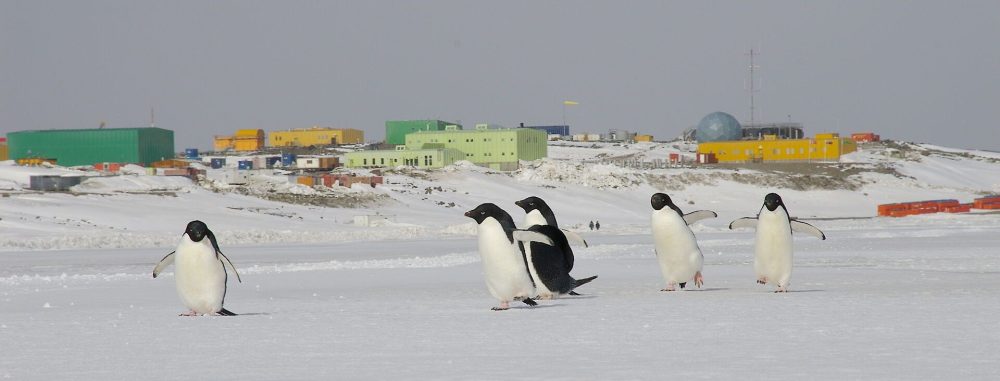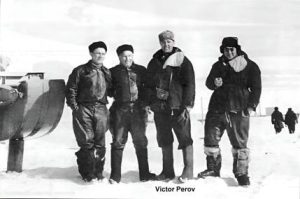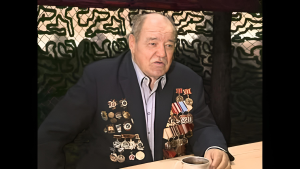 |
 Viktor Perov piloted aircraft serving the Polar Stations SP-2, SP-3, SP-4 and SP-5. While working in the Arctic, Perov had to rescue people in distress more than once. In 1956, he participated in the rescue of the Norwegian-Swedish-Soviet expedition to Svalbard.
Viktor Perov piloted aircraft serving the Polar Stations SP-2, SP-3, SP-4 and SP-5. While working in the Arctic, Perov had to rescue people in distress more than once. In 1956, he participated in the rescue of the Norwegian-Swedish-Soviet expedition to Svalbard.
In 1957-1959, Perov worked as part of a Soviet Expedition to Antarctica. December 11, 1958 in the Crystal Mountains (Antarctica, coordinates: 72°00′ South, 29°00′ West. d.HGAO), 250 km from the Belgian Antarctic Station “King Baudouin” (WAP BEL-Ø1), a plane crashed with a Belgian expedition on board. Among the members of the expedition was Prince Antoine de Ligne (fr.) Rus.. The Captain of the Belgians was Gaston de Gerlache. Soviet polar explorers from Mirny Station (WAP RUS-Ø7) offered assistance in their rescue, and the Australian Mawson Sation (WAP AUS-Ø4) supported the flights. Viktor Perov was appointed commander of the aircraft (Li-2 with the tail number H-495) sent to search for them. The search was conducted in the most difficult weather conditions, in the absence of accurate maps and problems in radio communication.  The situation was complicated by the unexplored terrain, which the Belgians flew out to map. After several days of searching, on December 16, the Belgian polar explorers were found and rescued. For this feat, Viktor Perov was awarded the Order of Leopold II in 1959, and the Order of the Crown in 2001.
The situation was complicated by the unexplored terrain, which the Belgians flew out to map. After several days of searching, on December 16, the Belgian polar explorers were found and rescued. For this feat, Viktor Perov was awarded the Order of Leopold II in 1959, and the Order of the Crown in 2001.
Later, Viktor Perov was chairman of the Polar Commission of the Moscow Center of the Russian Geographical Society and co-chairman of the Soviet-Belgian Friendship Society. He wrote a book of memoirs “Polar Routes”.
TNX Oleg UA6GG (https://www.dxtrophy.com/)

Viktor Perov a piloté des avions desservant les stations polaires SP-2, SP-3, SP-4 et SP-5. Alors qu’il travaillait dans l’Arctique, Perov a dû secourir des personnes dans
détresse plus d’une fois. En 1956, il participe au sauvetage de l’expédition norvégienne-suédo-soviétique au Svalbard.
En 1957-1959, Perov a travaillé dans le cadre d’une Expédition soviétique en Antarctique. 11 décembre 1958 dans les Montagnes de Cristal (Antarctique, coordonnées : 72°00′ Sud, 29°00′ Ouest. d.HGAO), à 250 km de la Station Antarctique Belge « King Baudouin ” (WAP BEL-Ø1), un avion s’est écrasé avec une expédition belge à bord. Parmi les membres de l’expédition se trouvait le prince Antoine de Ligne (fr.) Rus.. Le capitaine des Belges était Gaston de Gerlache. Les explorateurs polaires soviétiques de la station Mirny (WAP RUS-Ø7) ont offert leur aide pour leur sauvetage, et la station australienne Mawson < /strong> (WAP AUS-Ø4) a pris en charge les vols. Viktor Perov a été nommé commandant de l’avion (Li-2 avec le numéro de queue H-495) envoyé pour les rechercher. La recherche a été menée dans les conditions météorologiques les plus difficiles, en l’absence de cartes précises et de problèmes de communication radio. 
La situation était compliquée par le terrain inexploré, que les Belges se sont envolés pour cartographier. Après plusieurs jours de recherche, le 16 décembre, les explorateurs polaires belges ont été retrouvés et secourus. Pour cet exploit, Viktor Perov a reçu l’Ordre de Léopold II< /strong> en 1959, et l’Ordre de la Couronne en 2001.
Plus tard, Viktor Perov a été président de la Commission polaire du Centre de Moscou de la Société géographique russe et coprésident de la < strong>Société d’amitié soviéto-belge. Il a écrit un livre de mémoires ‘Routes polaires’.
TNX Oleg UA6GG (https://www.dxtrophy.com/)
Info de la Source Publié * ICI








